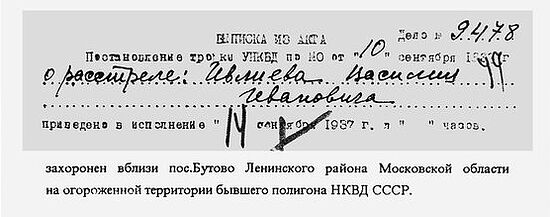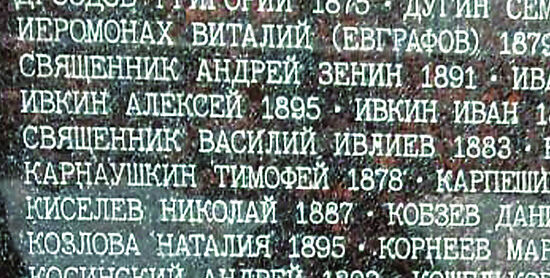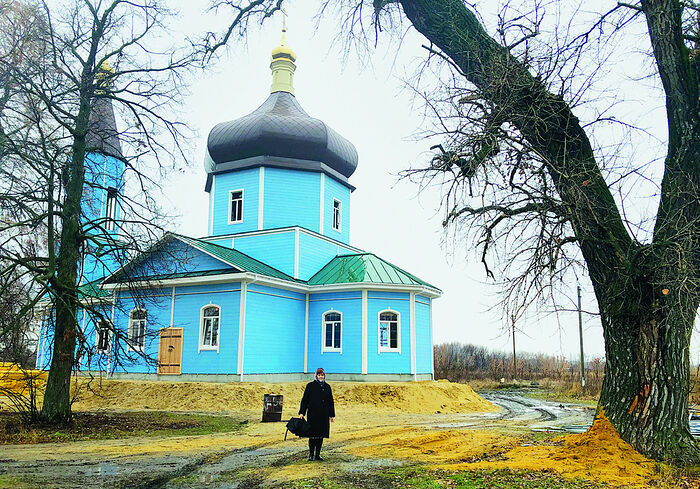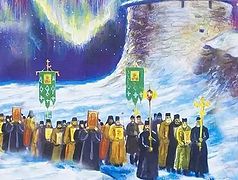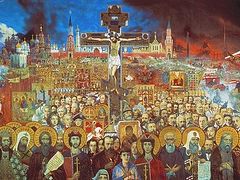Those of the New Martyrs of Russia who were not executed at the same time—in the first years of the revolution (as most of them were), were killed by backbreaking labor in the camps, but more often they were shot—at the Butovo firing range.
At the Butovo firing range, the mind’s eye only begins to reveal what was happening here…
Hundreds of people were executed, including women and children. About a thousand of those killed were bishops, priests, monastics, and active laypeople of the Russian Orthodox Church. Usually the condemned in those days were forced to dig their own graves, but then they decided to dig long, 4–4.5-meter-deep and wide ditches using an excavator to hasten the mass executions.
Operational order No. 00447 of the NKVD on July 30, 1937 was of a planned nature: many “former kulaks, convicts, and other “anti-Soviet elements” (here they could write in anyone they wanted)” were ordered to be exterminated. And the eager executioners, with a simple salute of obedience, “came up with a plan”, which is evident from the statistics of those killed per month—the largest number on December of 1937—they were in a hurry to close the reporting period. They began in a great hurry—the first almost one hundred people were terminated on August 8. Which means that ten days had not passed since the order was issued.
These people were sentenced to death without trial, without the right to legal defense, or even to utter a word. In fact, the condemned were not warned of what awaited them—this was specially stipulated in the order. Otherwise, people might begin to resist, since they had nothing to lose.
There at the Butovo firing range they were not even always shot, although these satanic troikas1 continued, as if mesmerized by telegrams from their leader2, to crudely hammer out the following directives: SHOOT. SHOOT. SHOOT. In our days, with the blessing of His Holiness, Patriarch Alexiy II, one of the thirteen massive and expansive Butovo mass graves was opened. In each of the graves the remains of thousands of the slain were layered. But shell casings and bullets were almost never found. People may have been buried alive here, tortured half to death in the “gas vans” invented by one of the ringleaders of the executioners at the Butovo firing range—Isaiah Berg.3
Sometimes, however, one would come across a pair of rubber gloves turned inside out in the ditches, which is eerily reminiscent of the epidemic of our days. Who but God knows how much of the truth is still hidden, and for what He has allowed us to experience the present scourge? Although who knows but this may be another harvest, when the Lord takes the best. But what then awaits those of us who remain?
At the event that took place the Butovo Firing Range museum, which we’ll discuss below, it was very importantly pointed out that in the late 1930s, just like now, a premonition of the future was in the air.
Why are we carrying out the plans of the criminals?
Archpriest Kirill Kaleda, rector of the two Butovo churches of the Resurrection of Christ and the New Martyrs and Confessors of the Church of Rus’ respectively, says that he has met with a resident of a village next to Butovo, who earlier, after World War II, worked in the NKVD as a driver and drove those killed in Moscow prisons to the Butovo mass graves for burial:
“The number of victims according to the execution lists—and this is referring to the period we know about—is 20,761 people from August 8, 1937 to October 19, 1938. And that’s far from complete. We can say at least around 30,000 people certainly lie at the Butovo firing range.”
If the duration of the “work shift”, (although labor is traditionally associated with creativity, not murder) is divided by the maximum number of people killed per day—562 people—it is clear that less than a minute was allotted to kill each human being.
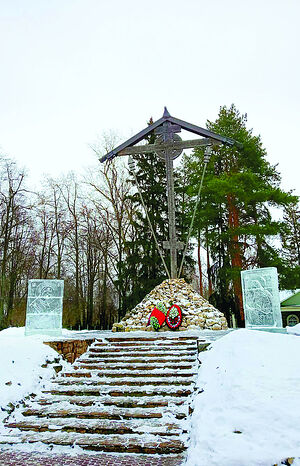 According to church tradition, the Last Judgment will last just a few minutes. Everyone will rise up from thousands of such mass graves—those known and often unknown, spread throughout almost all of Russia and not only in the former USSR.4 Even those among the most “honored” are continuing to devour billions while people are in poverty, as people take care of this “honor” in the mausoleum showcase located in the very center of the Paschal “Red Square” of our country, which is still being destroyed by this monster [Lenin]. For we are approaching the centennial of Lenin’s legalization of abortion, which has caused the dismemberment of several hundred million citizens—those whose ancestors he and his henchmen did not have time to butcher, and who are still being dismembered before being born.
According to church tradition, the Last Judgment will last just a few minutes. Everyone will rise up from thousands of such mass graves—those known and often unknown, spread throughout almost all of Russia and not only in the former USSR.4 Even those among the most “honored” are continuing to devour billions while people are in poverty, as people take care of this “honor” in the mausoleum showcase located in the very center of the Paschal “Red Square” of our country, which is still being destroyed by this monster [Lenin]. For we are approaching the centennial of Lenin’s legalization of abortion, which has caused the dismemberment of several hundred million citizens—those whose ancestors he and his henchmen did not have time to butcher, and who are still being dismembered before being born.
That is why, they say, the Last Judgment will not take or need much time, as everyone will simply appear as he or she is. They will either be clothed in garments whitened with suffering for the testimony of the Word of God (see: Rev. 7:14. It is symbolic that the main altars of the churches dedicated to the New Martyrs and Confessors of the Russian Church in Butovo and on Lubyanka, from where the condemned were sent out on the path to Golgotha, were consecrated in honor of the Resurrection of Christ, and these churches themselves are emphatically light, with white overtones). Or they will be clothed in the stench of the consequences of sins: you can still be washed whiter than snow, no matter how grave your atrocities were (See: Isa. 1:18) by the confession of Christ. But everyone (and his descendants, as many as they may be), can choose is he wishes.
It’s terrible that the pits of Butovo, which swallowed tens of thousands of lives, are located in the very center of the very hectares of land that produced food for the NKVD—which means that they were fed from these places. And this area is still named “in honor” of the ringleader-executioners of hundreds of millions. Does anyone really like to associate themselves not only with the names, but even the nicknames of revolutionaries pursuing a genocidal policy? It's like being complicit yourself!
It is the same with sponsoring the murder of your own people at taxpayer expenses, which is exactly what happens when abortion is included in the compulsory health insurance system.5 If everyone is involved in these massacres, then everyone is responsible—the entire nation. And this was all part of plans of the God-fighting godless authorities, to (as all criminal gangs do) try and smear and bind everyone with blood.
“If we allow ourselves to forget this, it will happen all over again”
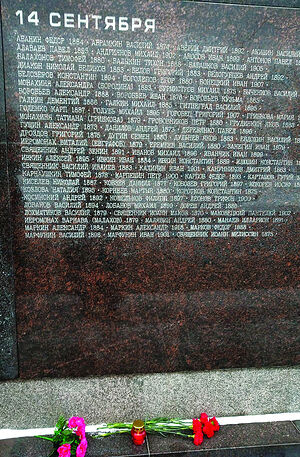 When books come out exposing these atrocities, they strike us as like lightning bolts in our often musty atmosphere of compromise; with our streets, squares, metro stations, etc. named in honor of these mass murderers, and monuments to these same misanthropists everywhere, bringing on a sort of oppression, or even bravura (pride or identity with them)—which also exists among the people. One such shocking truth was in the book, Priest Vasily Ivliev: I do NOT plead guilty.
When books come out exposing these atrocities, they strike us as like lightning bolts in our often musty atmosphere of compromise; with our streets, squares, metro stations, etc. named in honor of these mass murderers, and monuments to these same misanthropists everywhere, bringing on a sort of oppression, or even bravura (pride or identity with them)—which also exists among the people. One such shocking truth was in the book, Priest Vasily Ivliev: I do NOT plead guilty.
It was compiled by Grigory Ivliyev, the great-grandson of Fr. Vasily, who was murdered among many others at the Butovo range. Ivliyev is now the head of the Federal Service for Intellectual Property (Rospatent). A lawyer by training, he took and meticulously collected an entire selection: protocols of interrogations, investigative documents, testimony of witnesses, denunciations… And you find yourself inside what was happening and realize, leafing through these pages, where the torture had already begun. You look at the signature of the person being interrogated and see how distinct it was, as if under pressure, and what would happen to the person and later on.
“You read: [so-and-so] returned from exile [in labor camps], let it slip that the food was bad there; fought with a peasant; suggested that the collective farms would disintegrate… Oh well, the writer Andrei Gelasimov enumerates in a carefree tone. And then the troika decides: ‘SHOOT.’ ‘For what?’6 asks the first deputy chairman of the board of the Union of Writers of Russia, Doctor of Historical Sciences Igor Yanin, and he himself states the obvious: ‘For nothing!’ Although the recently reposed Archpriest Dimitri Smirnov, whose great-grandfather Hieromartyr Vasily Smirnov was also buried in the Butovo ditches, often specified that the question should have been: ‘For what purpose?’7 Often the purpose was simply so that the murderers could confiscate the possessions of those sent to death.”
Further in the same passage an extract from the documents reads: [order of execution] carried out to completion. According to the “laws”, the exact time should have been indicated. But who was even counting if murders were regularly carried out in less a minute?
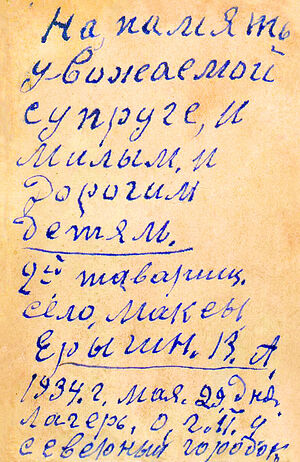 Then in the same book there are certificates of rehabilitation, posthumously granted. A photo with his wife and daughter. This is a very poignant sequence of photographs. A photo from the labor camp: “for the happy memory of a beloved wife and sweet and dear children.” And the name is already on memorial wall in the garden of memory of the victims of the Butovo firing range. He is one of the 164 killed on September 14, 1937. In total, 3163 people were killed there in September.
Then in the same book there are certificates of rehabilitation, posthumously granted. A photo with his wife and daughter. This is a very poignant sequence of photographs. A photo from the labor camp: “for the happy memory of a beloved wife and sweet and dear children.” And the name is already on memorial wall in the garden of memory of the victims of the Butovo firing range. He is one of the 164 killed on September 14, 1937. In total, 3163 people were killed there in September.
“But it’s one thing when you look at statistics, and quite another thing when you immerse yourself in the life of a specific person,” said Roman Romanov, director of the Gulag History Museum, a member of the Interdepartmental Working Group on Perpetuating the Memory of Victims of Political Repression. Although, if not abstractly perceived, the numbers are also amazing.
“I often have to work with archives in different cities and regions,” said Mikhail Fedotov, chairman of the Human Rights Council and adviser to the President of Russia. “You read the letters of priests from the same Smolensk region. They did not have time then, during the years of persecution, to report to their hierarch about every priest in every village who was executed.”
“If we allow ourselves to forget this, it will happen all over again,” warns Schema-Archimandrite Ilia (Nozdrin).
As Metropolitan Mark of Ryazan and Mikhailov recalled, the very presentation of the book about the murdered Ryazan priest took place on the commemoration day of another Ryazan native, the first of those killed by the Bolsheviks, Hieromartyr John Kochurov [who famously served in Chicago, and is counted among the Saints of North America as well—Trans.] The news of his martyrdom reached the fathers of the Local Council of the Russian Church of 1917-1918, gathered in Moscow, whose memory we recently celebrated on November 18—many of whom would also be slaughtered later on.
“Why do you defend the feelings of believers in Russia?" said a perplexed American to Vakhtang Kipshidze, the Deputy Chairman of the Synodal Department of the Moscow Patriarchate for Church Relations with Society and Mass Media. “It’s you in America, who go around saying that there was no Holocaust, but try to say that in Germany and you will not be understood, and could even be fined. These questions arise among you because nothing happened in the States similar to what Russia lived through,” he replied.
Why not look the truth in the eyes?
In the first pages of the book are the memoirs of the murdered Priest Vasily Ivliev’s granddaughter, Zinaida Ivlieva. She is a doctor by profession. Her story is touching, where the narrative of her grandfather’s marriage for love is interspersed with evidence of an imposed personality cult.
Is a society that has practiced denunciations for decades—something very clearly recorded in the memoirs—perhaps looking for the guilty party by force of habit? If there was no repentance, did it perhaps simply become ingrained in our nation’s psychology? Isn't this why the virus epidemic got started? A prophecy transmitted by Fr. John (Krestyankin) has recently been made known to us: “Stand, and look at what I have allowed to happen, to bring you to reason: The unsudden death of people. Do not look for who is to blame. Do not look for who is to blame. Pray! Be careful always, and in everything.”
The book very vividly depicts the habit of looking for a guilty party to blame [very common in the Soviet system]—like for instance the idle among hard workers—which can be read about in quotes from denunciations. You can also read about how collected interrogation reports describe property before 1917, after 1929 (the year when collectivization began), and at the time of arrest. Like for example a workaholic father robbed by those who seized power and completely was rendered utterly impoverished, forced to huddle in a bathhouse he built with his own hands. But even that was deemed too much room by those “lords of life”.
“And the truth about these heinous atrocities is still hidden from us,” noted the book’s compiler Grigory Ivliev. Despite the fact that all the names of informers and investigators are consistently blacked out in issued documents, not everyone can even get hold of these papers, even about their own relatives. Historian Valery Alekseev referred to how he had to resort to administrative resources in order to bring his grandfather’s file from somewhere in the Chelyabinsk region. “There were only four pages!” (At the time this was enough to kill a person; sometimes the executioners did not bother to write anything at all). Although, the families have always known the names of those informers. Almost everyone who gathered at this event had victims in their families.
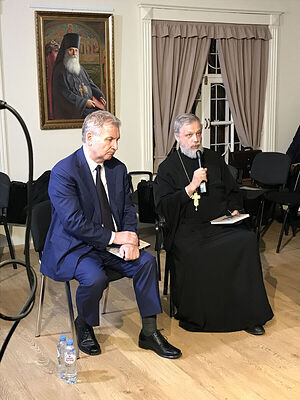 Sergei Popov, advisor to the general director of the Russian space agency, said that his wife's grandfather, as he once learned during conversations with then Metropolitan of Kaliningrad and Smolensk, now Patriarch Kirill of Moscow and All Russia, was imprisoned in Solovki with the latter’s grandfather. “And then,” the Patriarch said to author of the book Grigory Ivliev, “he was in the Arkhangelsk labor camps with your grandfather. Can you imagine how everything is intertwined?”
Sergei Popov, advisor to the general director of the Russian space agency, said that his wife's grandfather, as he once learned during conversations with then Metropolitan of Kaliningrad and Smolensk, now Patriarch Kirill of Moscow and All Russia, was imprisoned in Solovki with the latter’s grandfather. “And then,” the Patriarch said to author of the book Grigory Ivliev, “he was in the Arkhangelsk labor camps with your grandfather. Can you imagine how everything is intertwined?”
“We must pay tribute,” noted Doctor of Historical Sciences Igor Yanin. “Thanks to the Church, the search for truth has begun in this country.”
“The horror of millions killed, the grief and fear of their relatives and friends is what has bound this country in chains. It's time to break these chains! Time to declare that they [the Godless authorities] really were mass murderers, and we ourselves worshiped them. And maybe we continue to worship them? Why not face it? If the people do not face up to this, they will never be able to free themselves from this heavy, deadly burden,” warned Metropolitan Mark of Berlin and Germany (Arndt) of the Russian Orthodox Church Outside Russia (ROCOR). “Otherwise, this disease will worsen from generation to generation, and mutate and cripple new generations.”


